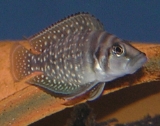
Altolamprologus
Encyclopedia
Altolamprologus is a small genus
of pseudocrenilabrine
cichlid
s endemic to Lake Tanganyika
in eastern Africa
. They inhabit areas of the lake with large amounts of rock, most frequently in water two to ten metres in depth. Two formally described species comprise this genus, with perhaps one dwarf A. compressiceps-like species being considered an unedescribed species by some. Neolamprologus fasciatus is also considered by some to belong to this genus.
They are moderately-sized Lamrologines
, growing to a total length of 13-15 cm (c.5-6 inches) in adult males. Their bodies are laterally compressed and remarkably high-backed; hence the scientific name which means "high Lamprologus
" (from Latin
altus, "high"). They are predators which feed on large invertebrate
s and small fish, particularly crustacean
s and juveniles of other cichlids.
s.
They can be a challenge to breed for the novice. These fish are cave spawners and will spawn under terracotta pot saucers or in large snail
shells. They are a rather slow growing Lamprologine taking approximately two years to reach sexual maturity.
Genus
In biology, a genus is a low-level taxonomic rank used in the biological classification of living and fossil organisms, which is an example of definition by genus and differentia...
of pseudocrenilabrine
Pseudocrenilabrinae
The Pseudocrenilabrinae is a subfamily in the cichlid family of fishes to which, according to a study from 2004, includes all the Middle Eastern and African cichlids with the exception of the unusual Heterochromis multidens and the Malagasy species. Previous authors recognized additional African...
cichlid
Cichlid
Cichlids are fishes from the family Cichlidae in the order Perciformes. Cichlids are members of a group known as the Labroidei along with the wrasses , damselfish , and surfperches . This family is both large and diverse. At least 1,300 species have been scientifically described, making it one of...
s endemic to Lake Tanganyika
Lake Tanganyika
Lake Tanganyika is an African Great Lake. It is estimated to be the second largest freshwater lake in the world by volume, and the second deepest, after Lake Baikal in Siberia; it is also the world's longest freshwater lake...
in eastern Africa
Africa
Africa is the world's second largest and second most populous continent, after Asia. At about 30.2 million km² including adjacent islands, it covers 6% of the Earth's total surface area and 20.4% of the total land area...
. They inhabit areas of the lake with large amounts of rock, most frequently in water two to ten metres in depth. Two formally described species comprise this genus, with perhaps one dwarf A. compressiceps-like species being considered an unedescribed species by some. Neolamprologus fasciatus is also considered by some to belong to this genus.
They are moderately-sized Lamrologines
Lamprologini
Lamprologini is a tribe of African cichlid fishes. It contains seven genera and nearly 100 species. Over half of the species in this tribe are in the large genus Neolamprologus. Most genera in the tribe are endemic to Lake Tanganyika, but one species of Neolamprologus Lamprologini is a tribe of...
, growing to a total length of 13-15 cm (c.5-6 inches) in adult males. Their bodies are laterally compressed and remarkably high-backed; hence the scientific name which means "high Lamprologus
Lamprologus
Lamprologus is a genus of fishes from the cichlid family. They are native to Lake Tanganyika and the Congo River Basin in Africa. The type species for this genus is Lamprologus congoensis, a species from the Congo River. The genus is under some revision and may eventually be restricted to these...
" (from Latin
Latin
Latin is an Italic language originally spoken in Latium and Ancient Rome. It, along with most European languages, is a descendant of the ancient Proto-Indo-European language. Although it is considered a dead language, a number of scholars and members of the Christian clergy speak it fluently, and...
altus, "high"). They are predators which feed on large invertebrate
Invertebrate
An invertebrate is an animal without a backbone. The group includes 97% of all animal species – all animals except those in the chordate subphylum Vertebrata .Invertebrates form a paraphyletic group...
s and small fish, particularly crustacean
Crustacean
Crustaceans form a very large group of arthropods, usually treated as a subphylum, which includes such familiar animals as crabs, lobsters, crayfish, shrimp, krill and barnacles. The 50,000 described species range in size from Stygotantulus stocki at , to the Japanese spider crab with a leg span...
s and juveniles of other cichlids.
In the aquarium
Altolamprologus are hardy at the standard Lake Tanganyikan water parameters. They are not particularly well-suited for beginners due to their predatory habits however. They can be picky eaters and demand a variety of appropriate living prey to thrive, but they are also prone to gorging themselves if they like the offered food and may become too fat. They also require large tanks – at least one meter/yard in length – to show their natural behavior, and cannot be kept together with small fish or shrimpShrimp
Shrimp are swimming, decapod crustaceans classified in the infraorder Caridea, found widely around the world in both fresh and salt water. Adult shrimp are filter feeding benthic animals living close to the bottom. They can live in schools and can swim rapidly backwards. Shrimp are an important...
s.
They can be a challenge to breed for the novice. These fish are cave spawners and will spawn under terracotta pot saucers or in large snail
Snail
Snail is a common name applied to most of the members of the molluscan class Gastropoda that have coiled shells in the adult stage. When the word is used in its most general sense, it includes sea snails, land snails and freshwater snails. The word snail without any qualifier is however more often...
shells. They are a rather slow growing Lamprologine taking approximately two years to reach sexual maturity.

